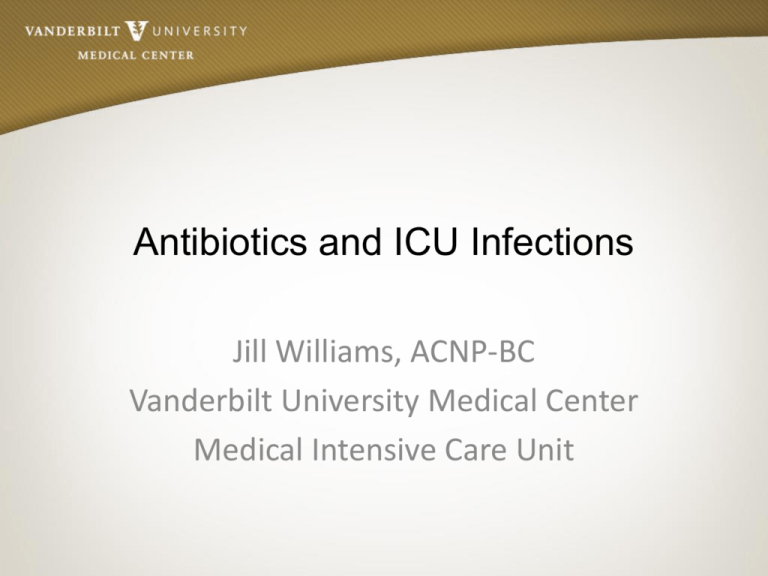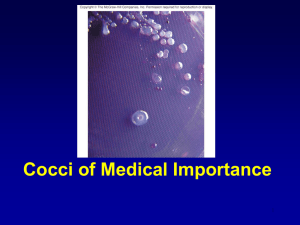Staphylococcus aureus - Vanderbilt University Medical Center
advertisement

Antibiotics and ICU Infections Jill Williams, ACNP-BC Vanderbilt University Medical Center Medical Intensive Care Unit Objectives • Discuss strategies for antibiotic stewardship • Review mechanisms of action (MOA) for antibiotics • Discuss common ICU infections and antibiotic therapies including drug levels Antibiotic Stewardship • What is it? – Program to monitor use of antibiotics – Coordinated effort between pharmacist and medical team • Why do we need it? – To help achieve optimal clinical outcomes – Minimize development of resistant strains of bacteria – Decrease healthcare costs R/T toxicity and adverse events Antibiotic Stewardship – How? • • • • • • Identify patient risk factors Know the hospital or unit antibiogram Review previous lab results and susceptibilities Consult with your pharmacist Monitor drug levels when appropriate Collaborate with an infectious disease specialist Structure of Bacteria www.americanaquariumproducts.com Antibiotic Mechanism of Action Extended Spectrum Beta Lactamases • ESBLs – Increasing cause of nosocomial infections – Becoming prevalent in the community – Higher mortality rates, longer hospital stays • Action of ESBLs – Open beta lactam ring on the antibiotic – Opening of beta lactam ring = deactivation of antibiotic ESBL’s • Common Culprits – Klebsiella pneumoniae – Klebsiella oxytoca – Escherichia coli • Resistance – 3rd generation cephalosporins and monobactams • Lab Testing – Check sensitivities – Resistance to ceftazidime, ceftriaxone, or cefepime = high likelihood of ESBL ESBL Risk Factors • • • • • Hospital LOS* ICU LOS* Central venous catheters Arterial catheters Emergent abdominal surgery • Gut colonization • Presence jejunostomy or gastrostomy tube • Prior antibiotics • Residence in long-term care facility* • Severity of illness • Presence of urinary catheter • Hemodialysis* • Ventilatory assistance Treatment • Carbapenem family of antibiotics – – – – – Only proven therapeutic option for infections Imipenem✴ Meropenem✴ Doripenem Ertapenem • Duration of treatment – No longer than indicated with other antibiotics – Ex: 10-14 days depending on infection Carbapenems Drug Dose Duration Comments Imipenem 500mg IV q 6-8 hours 7-14 days depending on severity of infection Adjust dose for renal impairment; lowers seizure threshold vs. meropenem Meropenem 500mg – 1gram IV q 8 hours Dependent on severity of infection No renal adjustment needed Doripenem 500mg q8 hrs 7-14 days Newer drug; renally dose 5-14 days Not active against pseudomonas; not recommended for ICU Ertapenem 1 gram daily Methicillin Resistant Staph Aureus (MRSA) • Risk factors – Prior cephalosporin or quinolone use – HIV infection – Long-term indwelling dialysis catheters – Residence in long-term care facility MRSA Treatment • Bacteremia** – Vancomycin • 15 – 20 mg/kg based on actual body weight • Frequency of dose dependent on renal function OR – Daptomycin • 6mg/kg/dose IV daily • 8-10mg/kg/dose IV daily for complicated infections • Pneumonia – Vancomycin • 15 – 20 mg/kg based on actual body weight • Frequency of dose dependent on renal function OR – Linezolid • 600mg IV or PO BID – NO Daptomycin • Poor lung penetration Vancomycin • Treats multiple infections – Endocarditis, osteomyelitis, bacteremia, HCAP, meningitis • Optimal level 15 – 20 mg/L • Keep level > 10 mg/L to avoid potential antimicrobial resistance • Trough level = most effective measurement of levels – Draw 30 min prior to 5th dose Vancomycin Nephrotoxicity • Definition: – > 50% increase in Serum Creatinine over baseline on consecutive serum measurements (over 2 days) in the absence of alternative explanations • Increased risk toxicity: – Elderly, longer course of treatment, concomitant nephrotoxic medications, possibly increased serum trough levels • Reduce toxicity: – Monitor levels with fluctuating renal function Vancomycin Resistant Enterococci • • • • • • • Occurs in intestine and female urinary tract Distinguish between active infection and colonization E. Faecalis and E. faecium most common forms More than 90% cases E. faecium Limited studies for most effective drug No official ID Guidelines Treatment based on available data: – Linezolid 600mg PO/IV BID OR – Daptomycin 6mg/kg/dose daily** Fungal Infections Risk Factors Disseminated Disease • Duration of antibiotics – > 6 days • Number of antibiotics – ≥ 3 therapies • Renal failure • Central venous catheters • Steroid use • • • • • • • Gram negative sepsis Cancer Burns Multiple trauma Diabetes mellitus Total parenteral nutrition Neutropenic vs. Nonneutropenic Common Fungal Species • Candida – – – – – – C. albicans C. tropicalis C. parapsilosis C. glabrata C. krusei C. lusitaniae • Aspergillus Treatment Options • Azoles – Fluconazole, voriconazole, itraconazole, posaconazole • Echinocandins – Micafungin, caspofungin, anidulafungin • Polyenes – Amphotericin B + lipids Drug Fluconazole Itraconazole Voriconazole Posaconazole Bioavailability Metabolism > 90% IV and PO Highly variable >90% <50% Adverse Effects Comments >80% excreted unchanged in urine Alopecia Chapped lips Active agst yeast; itraconazole better for fungi Extensive in liver HTN Hyperkalemia Peripheral Edema Capsule and solution NOT interchangeable Cardiac toxicity Rash Periostitis Penetrates CSF; adjust for hepatic impairment Extensive in liver Liver GI symptoms Torsades Increased concentration with increased administration Drug Dosing Fluconazole* • Esophageal Candida: 400 mg load; 200mg qday • Invasive disease: 800mg load; 400mg qday Itraconazole • Histoplasmosis: 200 – 400 mg qday • Allergic bronchopulmonary aspergillosis: 200 mg BID Voriconazole • Candidemia: Load: 6 mg/kg IV q12hr x 2 doses; Maintenance: 3 – 4 mg/kg q12 hrs • Aspergillosis: Load: 6 mg/kg IV q12hr x 2 doses; Maintenance: 4 mg/kg IV q12 hr Drug Dosing Posaconazole • Prophylaxis: 200 mg PO TID** • Salvage therapy: 200 mg PO QID Serum Drug Levels • Itraconazole – Check level after steady state achieved (suggested 2 weeks) – For invasive fungal infections: >3 mcg/mL by bioassay – Linear relationship between increased levels and toxicity • Voriconazole – Check 4 – 7 days into therapy (TROUGH level) – Invasive fungal infections: 1 mg/L → < 5.5 mg/L • Posaconazole – No official guidelines for therapeutic levels – Suggestion: Trough level • Prophylaxis: ≥ 0.5 mcg/mL • Severe infection: ≥ 0.7 mg/mL Echinocandins Indication Caspofungin Micafungin Anidulafungin Esophageal candidiasis No loading MD*: 50 mg QD No loading MD: 150 mg QD Loading: 100mg MD: 50 mg QD Candidemia Loading: 70 mg MD: 50 mg QD No loading MD: 100 mg QD Loading: 200 mg MD: 100 mg QD No loading MD: 100 mg QD Loading: 200 mg MD: 100 mg QD Other Candida infections Loading: 70 mg MD: 50 mg QD Febrile Neutropenia Loading: 70 mg MD: 50 mg QD N/A N/A Invasive Aspergillosis Loading: 70 mg MD: 50 mg QD N/A N/A Prophylactic Stem Cell N/A No loading MD: 50 mg QD N/A Clostridium Difficile Guidelines Severity of Disease Initial Treatment Duration of Treatment** Mild to Moderate Metronidazole 500mg TID 10-14 days 10-14 days Moderate to Severe Vancomycin 125mg PO QID Recurrence† (non-severe) Metronidazole 500mg TID 10-14 days Recurrence (severe) Vancomycin 500mg QID + Metronidazole 500mg IV TID 10-14 days References • Society of Critical Care Medicine. (2009). ICU infection in an era of multi-resistance; selected proceedings from the 8th summer conference in intensive care medicine. Mount Prospect: Certified Fiber Sourcing. • Brandt, L. J., & Feuerstadt, P. (2011). Clostridium difficile: Epidemiology, transmission, and treatment. Infectious Disease Special Edition, 14, 75-83. • Martin, S. J., Micek, S. T., & Wood, G. C. (2012). Antimicrobial resistance is an adverse drug event. In J. Papadopoulos, B. Cooper, S. Kane-Gill, S. Corbett & J. Barletta (Eds.), DrugInduced Complications in the critically ill patient: A guide for recognition and treatmentMount Prospect: Society of Critical Care Medicine. References • Rybak, M., Lomaestro, B., Rotschafer, J. C., Moellering Jr, R., Craig, W., Billeter, M., Dalovisio, J. & Levine, D. (2009). Therapeutic monitoring of vancomycin in adult patients: A consensus review of the american society of health system pharmacists, the infectious disease society of america, and the society of infectious disease pharmacists. American Journal Health System Pharmacists, 66, 82-98. Retrieved from http://www.ajhp.org • Liu, C., Bayer, A., Cosgrove, S., & Daum, R. (2011). Clinical practice guidelines but the infectious diseases society of america for the treatment of methicillin-resistant staphylococcus aureus infections in adults and children. Clinical Infectious Diseases, 52(3), e18-e55. Retrieved from http://cid.oxfordjournals.org References • Kelly, C. P., & LaMont, J. T. (2013, March). Clostridium difficile in adults:treatment. Retrieved from www.uptodate.com • Ashley, E. D., & Perfect, J. R. (2013, June). Pharmacology of azoles. Retrieved from www.uptodate.com • www.cdc.gov • http://www.idsociety.org • Kauffman, C. A., & (2013, July). Treatment of candidemia and invasive candidiasis in adults. Retrieved from www.uptodate.com • Chen, L. F., & Drew, R. H. (2013, April). Pharmacology of antimicrobial agents for treatment of methicillin-resistant staphylococcus aureus and vancomycin resistant enterococcus. Retrieved from www.uptodate.com References • Munoz-Price, L. S., & Jacoby, G. A. (2013, April). Extendedspectrum beta-lactamases. Retrieved from www.uptodate.com • Runyon, B. A., & (2013, July). Spontaneous bacterial peritonitis in adults: Treatment and prophylaxis. Retrieved from www.uptodate.com • Sucher, A. J., Chahine, E. B., & Balcer, H. E. (2009). Echinocandins: The newest class of antifungals. The Annals of Pharmacotherapy, 43, 1647-57. • The following slides exhibit various anatomical systems and common organisms responsible for infections. • Streptococcus – S. Viridans – S. Mutans • Fusobacterium (Leimerre’s disease) • Staphylococcus – S. aureus – S. epidermidis • • • • • • Strep pneumoniae Haemophilus influenzae Bordetella Staph. aureus Legionella pneumophilia Mycobacterium tuberculosis • Histoplasmosis • Enterobacteriaceae • Infective Endocarditis – Streptococcus viridans (50% of all cases) – Staphylococcus aureus – Enterococcus – HACEK organisms* • • • • • Haemophilus Actinobacillus Cardiobacterium hominis Eikenella corrodens Kingella (Kingella kingae) *slow growing gram (-) organisms; Normal part of human flora • Escherichia coli • Bacteroides • Infectious pancreatitis – – – – – – – Hepatitis B CMV Varicella-zoster HSV Mycoplasma Legionella Salmonella • • • • • • Bacteroides Enterococcus Escherichia coli Klebsiella pneumoniae Staphylococcus aureus Streptococcus • • • • • Escherichia coli Enterococcus Bacteroides Streptococcus Lactobacillus • • • • • • Clostridium difficile Escherichia coli Bacteroides Campylobacter Salmonella Shigella • • • • Escherichia coli Proteus mirabilis Klebsiella Pseudomonas aeruginosa • Enterococcus


